EULAR Sjögren's Syndrome Disease Activity Index (ESSDAI ...
EULAR Sjögren's Syndrome Disease Activity Index (ESSDAI ...
EULAR Sjögren's Syndrome Disease Activity Index (ESSDAI ...
Create successful ePaper yourself
Turn your PDF publications into a flip-book with our unique Google optimized e-Paper software.
inserm-00431527, version 1 - 12 Nov 2009<br />
component of this project we will also be evaluating the most common patient-reported<br />
symptoms such as dryness, pain and fatigue in a patient-completed questionnaire the ESSPRI.<br />
A major challenge in designing a systemic index is distinguishing between damage<br />
and disease activity. The most frequent approach, to avoid scoring damage, is to consider<br />
manifestations as active only if “new” or “worsening.” Under these scoring systems, when<br />
patients are evaluated at two time points, a persistent manifestation will not be rated at the<br />
second time point, which may cause an erroneous interpretation of improvement even though<br />
the patient’s condition has not changed. To avoid this, all <strong>ESSDAI</strong> items were defined<br />
without reference to a previous assessment, but with an advice not to rate as active stable<br />
long-lasting features related to damage.<br />
The <strong>ESSDAI</strong> is a systemic disease activity index developed to allow a standardized<br />
evaluation of disease activity in primary SS patients. Further studies are needed to assess the<br />
reliability and sensitivity to change of the <strong>ESSDAI</strong>. Once validated, if uniformly applied, the<br />
<strong>ESSDAI</strong> might enable comparison between studies and facilitate clinical research into<br />
primary SS. After the development of the patient-completed questionnaire (ESSPRI), the use<br />
of both the <strong>ESSDAI</strong> and ESSPRI for outcome assessment in randomized controlled trials<br />
should allow for assessing all facets of the disease.<br />
Acknowledgments:<br />
This project was supported by a grant from the European League Against Rheumatism<br />
(<strong>EULAR</strong>). We thank Maxime Dougados and Alan Tyndall for their guidance and support. We<br />
thank the <strong>EULAR</strong> house in Zurich for their hospitality and outstanding organization (Ernst<br />
Isler, Anja Schönbächler and their associates). We thanks the expert panel for their active and<br />
fruitful participation.<br />
"The Corresponding Author has the right to grant on behalf of all authors and does grant on<br />
behalf of all authors, an exclusive licence (or non exclusive for government employees) on a<br />
worldwide basis to the BMJ Publishing Group Ltd to permit this article (if accepted) to be<br />
published in ARD and any other BMJPGL products and sublicences such use and exploit all<br />
subsidiary rights, as set out in our licence (http://ARD.bmjjournals.com/ifora/licence.pdf)."<br />
LEGENDS OF THE FIGURES<br />
Figure 1. Distribution of <strong>ESSDAI</strong> scores and correlation with disease activity in real<br />
patient profiles and realistic vignettes<br />
Figures 2A, 2B, 2C refer to the 702 realistic clinical vignettes, and figures 2D, 2E, 2F refer to the 96<br />
real patient profiles. Distribution of <strong>ESSDAI</strong> scores in realistic vignettes (A) and real patient profiles<br />
(D), <strong>ESSDAI</strong> score for each level of global activity as defined by physicians on the 5-point scale (B<br />
and E), and correlation between <strong>ESSDAI</strong> scores and physicians’ ratings of disease activity by the<br />
physician global assessment (PhGA) scale (0-10 scale) (C and F).<br />
For box plots of <strong>ESSDAI</strong> scores, the boxes represent the 25th and 75th percentiles; the lines within the<br />
box represent the median; the dot inside the box, linked by a line, represents the mean; and the<br />
whiskers extend to the most extreme data point, which is no more than 1.5 times the interquartile<br />
range (difference between the 75th and 25th percentiles) from the box. Values that are more extreme<br />
were considered outliers and are plotted individually (dots).<br />
15




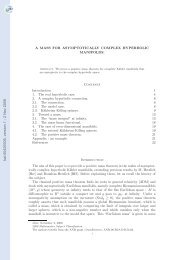

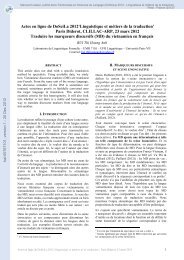
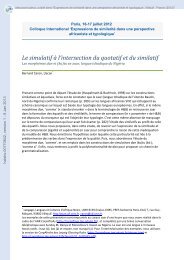
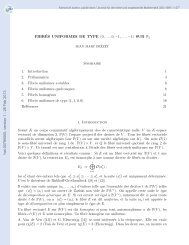
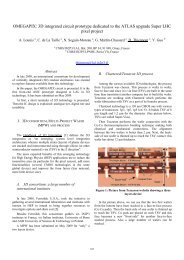
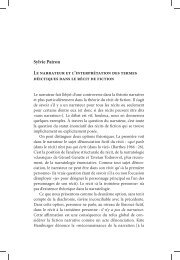
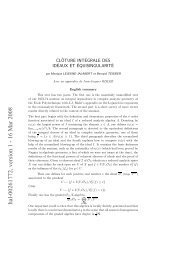
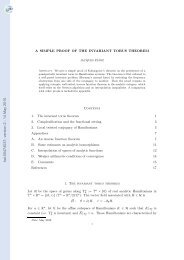

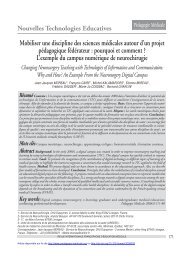

![[tel-00433556, v1] Relation entre Stress Oxydant et Homéostasie ...](https://img.yumpu.com/19233319/1/184x260/tel-00433556-v1-relation-entre-stress-oxydant-et-homeostasie-.jpg?quality=85)